
* The Saunders-Roe company of the UK got into the helicopter business with the lightweight piston-powered "Skeeter" helicopter, which led (after the company became part of Westland) to the turboshaft-powered "Scout" Army helicopter and its naval equivalent, the "Wasp". The Scout/Wasp was followed in turn by the "Lynx" combat helicopter, which proved very popular. This chapter discusses the Skeeter, Scout/Wasp, and army variants of the Lynx.
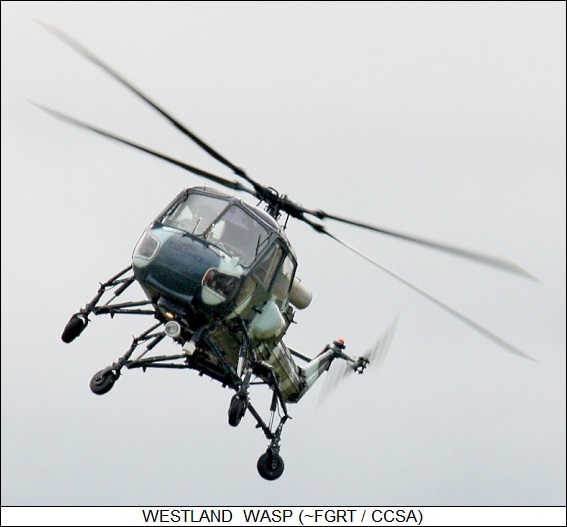
* Although autogyro pioneer Juan de La Cierva was killed in an airliner crash in 1936, his company survived through World War II. In the postwar period, the Cierva company developed a two-seat piston-powered helicopter, with the first flight of the initial prototype, the "W.14 Skeeter 1", on 8 October 1948. The prototype needed some work, which continued after the firm was bought out by the Saunders-Roe (SARO) company in 1951 -- the design progressing through improved "Skeeter 2" through "Skeeter 6" variants, featuring increasingly more powerful engines and other refinements.
After almost a decade of development, the Skeeter 6 seemed like it was ready for production, with the British government ordering a small evaluation batch, including three "Skeeter 6A / Air Observation Post Mark 10 (AOP.10)" machines for the British Army and one "Skeeter 6B / Trainer Mark 11 (T.11)" for the British Royal Air Force. The Skeeter 6 was of conventional main-tail rotor configuration; it featured a three-blade main rotor, a two-blade tail rotor, and tricycle wheeled landing gear. It was powered by a 150 kW (200 HP) air-cooled inline Gipsy Major 201 engine; the T.11 had twin controls.
The evaluation went well enough to lead to an order for a full service batch of "Skeeter 7" machines, similar to the Skeeter 6 but with an uprated Gipsy Major 215 engine, providing 160 kW (215 HP). The Army obtained 64 "Skeeter 7A / AOP.12" machines, with the RAF ordering a small number of "Skeeter 7B / T.13" rotorcraft. The Skeeter went into operational service in 1958. The West German Army also ordered six Skeeter 7s as the "Skeeter Mark 50", with the West German Navy ordering four more as the "Skeeter Mark 51".
___________________________________________________________________
SARO SKEETER 7:
___________________________________________________________________
main rotor diameter:
9.76 meters (32 feet)
tail rotor diameter:
1.83 meters (6 feet)
footprint length:
8.66 meters (28 feet 4 inches)
height (rotor head):
2.99 meters (9 feet 10 inches)
MTO weight:
1,000 kilograms (2,200 pounds)
maximum speed:
170 KPH (105 MPH / 95 KT)
service ceiling:
3,550 meters (11,650 feet)
range:
380 kilometers (235 MI / 205 NMI)
___________________________________________________________________
A "Skeeter 8" was designed for the commercial market, with one prototype built, but there were no sales. Skeeter production ended in 1960. The German Skeeters were passed on to Portugal in 1961. Skeeters were generally out of service by the end of the 1960s.
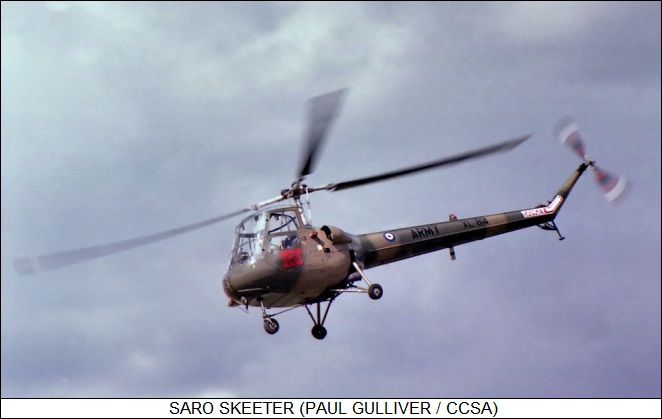
* The Skeeter was an endearing little machine that looks like it would have been great fun to fly, but it wasn't much more than a toy, and about ten years behind the times. The design team did acquire experience to help them develop more modern and useful rotorcraft, beginning work in 1957 on a general-purpose five-seat turboshaft-powered helicopter for a British Army requirement, with the Royal Navy expressing interest in a shipboard variant. The design project was given the designation of "P.531", with full development and construction of two prototypes authorized at the beginning of 1958.
The P.531 was also of conventional main-tail rotor configuration, with a four-blade main rotor and a two-blade tail rotor; it had a certain broad resemblance to the Skeeter, but was larger and more capable. Initial flight of the first prototype was on 20 July 1958, with the second prototype following on 30 September 1958. The prototypes were powered by a Blackburn (license-built French Turbomeca) Turmo turboshaft, with 240 kW (325 SHP), that engine having been trialed in a Skeeter. SARO was bought out by Westland in 1960, but the P.531 development program continued.
An improved prototype designated "P.531-2", powered by a Rolls-Royce Bristol Nimbus free-turbine turboshaft engine providing 510 kW (685 kW), performed its initial flight on 9 August 1959. The British Army expressed interest, with the production prototype of the Army variant, designated the "Scout AH.1", performing its initial flight on 4 August 1960. The Scout went into Army service in the spring of 1963, serving in the utility and armed helicopter roles, and seeing action of sorts in Northern Ireland. The Royal Navy also ordered the type, with the production prototype of the "Wasp HAS.1" performing its initial flight on 28 October 1962, and introduction to service in late 1963. It was used for utility and antisubmarine warfare roles.
* The Army Scout was powered by the Rolls-Royce Bristol Nimbus Mark 103 or 104 turboshaft with 530 kW (710 SHP). It featured a folding main rotor. Crew accommodations included two seats forward and a three-person bench seat in back. There were four hinged doors. The bench seat could be removed for cargo carriage, or for fit of two casualty litters, with another litter carried externally on each side of the helicopter for a total of four litters. External slung load was up to 680 kilograms (1,500 pounds). A rescue hoist was optional. The machine featured skid landing gear.
British Army Scouts were in some cases configured to carry four Nord (later Aerospatiale) SS-11 wire-guided antitank missiles, directed by a stabilized sight in the roof, and could be fitted to carry a single pintle-mounted light machine gun in one of the doors; another pintle-mounted machine gun could be in principle mounted on the other side, but that was a cramped fit. Alternative armament of two light machine guns could be carried in a fixed forward-firing configuration, with the weapons sighted by a simple graticule painted on the windscreen.
The total number of Scouts built for the British Army is unclear, with some sources giving as many as 160. Exports were modest: two for the Australian Navy, three for Jordan, two for the Ugandan police, and two for the Bahrain police.
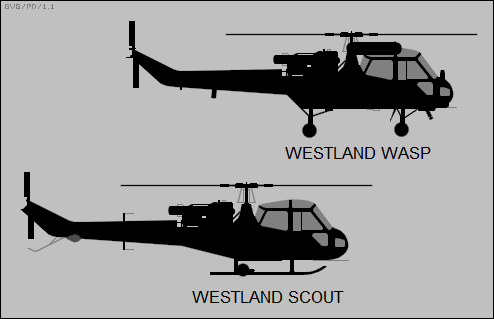
* The Royal Navy Wasp was similar to the Scout, but had four-wheel landing gear for deck handling. The landing gear was splayed and had heavy shock mounts to ease landing on pitching frigates and other vessels. The Wasp also had a folding tailboom; inflatable flotation gear carried in pods that looked like fuel tanks, mounted on struts alongside the upper fuselage; and the folding main rotor used on the Scout. A total of 245 kilograms (540 pounds) of offensive stores could be carried under the fuselage, including two homing torpedoes or depth charges. A few Wasps were configured to carry four SS.11, or two of the larger Nord AS.12, wire-guided missiles.
___________________________________________________________________
WESTLAND WASP HAS.1:
___________________________________________________________________
main rotor diameter:
9.83 meters (32 feet 3 inches)
tail rotor diameter:
2.29 meters (7 feet 6 inches)
fuselage length:
9.24 meters (30 feet 4 inches)
footprint length:
12.29 meters (40 feet 4 inches)
height (tail rotor):
3.56 meters (11 feet 8 inches)
height (rotor head):
2.72 meters (8 feet 11 inches)
empty weight:
1,565 kilograms (3,450 pounds)
MTO weight:
2,495 kilograms (5,500 pounds)
maximum speed:
195 KPH (120 MPH / 105 KT)
service ceiling:
3,720 meters (12,200 feet)
range:
490 kilometers (305 MI / 265 NMI)
___________________________________________________________________
A total of 98 Wasp HAS.1 helicopters was built for the Royal Navy, with most of these machines phased out by the late 1980s. Wasps served in the Falklands War, operating off older vessels that couldn't support more formidable helicopters, and fought in several clashes, as detailed later.
35 Wasps were also built for foreign air arms, including Brazil, Indonesia, Malaysia, the Netherlands, New Zealand, and South Africa. Brazilian Wasps were configured to carry unguided rocket pods. Some of the export Wasps lingered on in service into the 1990s, and a few may still be airworthy.
BACK_TO_TOP* In the mid-1960s, the British military had requirements for improved helicopters. Since the French military had a similar set of requirements, in early 1967 Westland of the UK and Aerospatiale of France signed an agreement to collaborate on helicopter development for their military forces. The collaboration focused on three helicopters. Aerospatiale was the design leader for a large helicopter, which would emerge as the "Puma", and for a light helicopter, which would emerge as the "Gazelle". Westland, took design leadership for a medium helicopter originally designated "WG.13".
Various elements of WG.13 technology were trialed on Scouts, and a mockup of the WG.13 was displayed at the Paris Air Show in 1970, with the machine given the name of "Lynx". The first WG.13 prototype performed its initial flight on 21 March 1971, painted bright yellow and with Ron Gellatly at the controls. Development was running a good part of a year behind schedule at that time, partly because Rolls-Royce was having troubles getting the BS.360 -- later known as the "Gem" -- powerplant up to specified rating.
Four more development prototypes were built, the last performing its initial flight on 8 March 1972. One set a world speed record of 321.7 KPH (199.8 MPH / 173.7 KT) on 20 June 1972, with Roy Moxam at the controls. The five prototypes were followed by eight preproduction machines, with subsets of the batch configured as British Army, Royal Navy machines, or Aeronavale (French naval air arm) machines. Lynx production deliveries began in 1977.
* The initial British Army production variant was the "Lynx AH Mark 1 (AH.1)", the first performing its initial flight on 12 February 1977, and going into formal service in 1978. The AH.1 provides a useful baseline for other Lynx variants.
As it emerged, the Lynx had little or no relationships to the Scout; in fact, it had a certain general resemblance to the US Bell UH-1 Huey. The Lynx was a conventional main-tail rotor design, with four-blade main and tail rotors. It was powered by twin Rolls-Royce Gem 2 turboshafts providing 670 kW (900 SHP) each, mounted on top of the fuselage. The Lynx AH.1 featured skid landing gear.
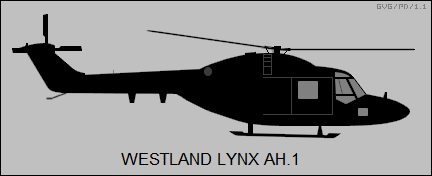
The Lynx AH.1 could carry a pilot and copilot in a side-by-side cockpit, with up to nine armed or twelve unarmed troops in a cabin with minimum length, width, and height of 2.06 x 1.78 x 1.42 meters (6 feet 9 inches x 5 feet 10 inches x 4 feet 8 inches) respectively. There were crew doors on each side of the cockpit and large sliding doors on both sides of the passenger / cargo cabin; all four doors could be jettisoned in an emergency. Other possible loads included three casualty litters plus an attendant; an internal cargo load of 900 kilograms (2,000 pounds); or a slung load of 1,360 kilograms (3,000 pounds). A Belgian FN MAG 7.62-millimeter (0.30-caliber) general-purpose machine gun (GPMG) could be mounted on a pintle in each door.
___________________________________________________________________
WESTLAND LYNX AH.1:
___________________________________________________________________
main rotor diameter:
12.8 meters (42 feet)
tail rotor diameter:
2.21 meters (7 feet 3 inches)
fuselage length:
12.06 meters (39 feet 7 inches)
footprint length:
15.16 meters (49 feet 9 inches)
height (tail rotor):
3.66 meters (12 feet)
height (rotor head):
2.96 meters (9 feet 9 inches)
empty weight:
2,785 kilograms (6,145 pounds)
max loaded weight:
4,535 kilograms (10,000 pounds)
maximum speed:
250 KPH (160 MPH / 140 KT)
hover ceiling:
3,230 meters (10,600 feet)
range:
540 kilometers (335 MI / 290 NMI)
___________________________________________________________________
A total of 113 Lynx AH.1s was obtained for the British Army and the Royal Marines into 1984, the machines being used for tactical troop transport, cargo transport, and casualty evacuation roles. The Royal Marines had hoped to obtain their own variant, the "Lynx AH.6", something like an AH.1 with navalizations such as wheeled landing gear, folding tailboom, and deck-capture harpoon system -- but in the end, the additional functionality of the AH.6 was not seen as worth the additional price, and the Royal Marines went with the AH.1.
* Pilots found the Lynx AH.1 extremely agile, due in large part to its French-designed titanium rotor hub, and great fun to fly. Although the Lynx AH.1 had been obtained for the utility role, its agility inspired the notion that it might make a good anti-armor helicopter as well, and so in the early 1980s 60 Lynx AH.1s were configured to carry the US Hughes TOW wire-guided antitank missile, with four missiles in a pack on each side of the helicopter, for a total of eight missiles, and a boxy M65 stabilized optical sight on top left side of the cockpit.
The TOW was a much more advanced weapon than the first-generation SS-11. The SS-11 had to be flown with a hand controller as though it were a model aircraft, which was tricky in the first place -- even trickier in a combat environment, where people were likely to be shooting back. In contrast, to guide the TOW all the gunner had to do was keep his eye on the target through his sight, with the sighting system automatically correcting the missile's flight. These TOW machines were formally designated "Lynx AH.1 TOW", but in practice they were almost always referred to as AH.1s. The TOW Lynx AH.1s were used by both the British Army and the Royal Marines.
While using a transport helicopter design as an anti-armor gunship was seen as somewhat backwards in places like the US and USSR, which had developed optimized helicopter gunships, the Lynx proved very competent in the role, with the roof-mounted sight allowing the helicopter to stay below the treeline while Westland / Aerospatiale Gazelle helicopters scouted targets. The cargo capacity of the Lynx allowed it to carry eight TOW reloads to improve its effectiveness on the battlefield, or drop a squad of troops with Milan light anti-tank missiles to set up tank traps.
* The 102nd production Lynx AH.1 was set aside as a trials machine and used for evaluating a wide range of fits, including the weapons fits such as 20-millimeter cannon and Stinger air-to-air missiles (AAM). It was also substantially reconfigured for an attempt on the pure rotorcraft world speed record, being aerodynamically cleaned up and fitted with:
The successful record flight was on 11 August 1986, with the machine flying a 15-kilometer (9.3-mile) course at an average speed of 400.87 KPH (249 MPH). The aircrew included pilot Trevor Eggington and flight engineer Derek Clews.
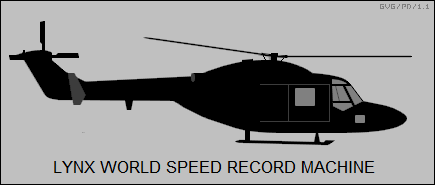
The demonstrator was later returned to a more conventional Army Lynx configuration and fitted with twin Allison-Garrett LHTEC T800 turboshafts, providing 1,007 kW (1,350 SHP) each. It was finally retired in 1995, and now resides at the Helicopter Museum in the UK.
BACK_TO_TOP* Following deliveries of the Lynx AH.1, the Army ordered five "Lynx AH.5" machines for evaluation -- similar to the AH.1, but featuring uprated powerplants and an improved power transmission system to handle the increase in power. The first three were fitted with Gem 41-1 turboshafts providing 835 kW (1,120 SHP) each and designated "AH.5 Interim", while the last two were full-spec AH.5s with Gem 42 turboshafts providing the same power levels.
The AH.5s led to the improved "Lynx AH.7" production variant, which featured the Gem 42 engines, plus:
The first AH.7 was an upgraded AH.5, performing its initial flight in its new configuration on 13 June 1986. A total of ten AH.7s was built new, including six originally ordered as AH.5s; some sources claim there were actually four AH.5s and eleven AH.7s. 107 more AH.7s were produced by upgrade of AH.1s and AH.5s. Some of the upgraded AH.1s were initially upgraded to an interim "AH.1GT" configuration, with the new engines and tail rotor, before being fully upgraded to AH.7 spec. The upgrades included TOW-equipped machines.
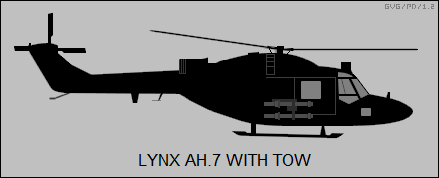
In service, the Lynx AH.7s were upgraded with the BERP main rotor, a Sky Guardian radar warning receiver (RWR) -- later replaced by the Marconi AWARE-3 RWR -- and other smaller improvements. Apparently a few AH.7s were obtained by the Special Air Service (SAS) commando organization, to be fitted with heavy mounts for 12.7-millimeter machine guns, and likely other specialized kit.
* The British Army made very good use of the Lynx. It saw extensive service in Northern Ireland, providing troop mobility in areas where ground transport might be nicked by a roadside bomb. At least one AH.7 was fitted with a "Chancellor" TV / infrared imaging ball turret on the left side of the fuselage behind the cargo door, with the turret used to observe Irish Republican Army activities.
Anti-tank Lynxes served with distinction in the 1991 Gulf War, known as Operation GRANBY in the UK in contrast to the American Operation DESERT STORM. The basic combat team consisted of two TOW Lynxes and two Gazelles, though sometimes larger hunter-killer groups were deployed. They were painted in desert sand colors and racked up big scores with TOWs on Iraqi armor. The TOW Lynxes were fitted with sand filters and countermeasures kit, including the hay box exhaust suppressors, the AN/ALQ-144 disco-light jammer, and the Sky Guardian RWR. The last AH.7s were retired in the summer of 2015.
BACK_TO_TOP* Even as the Lynx was establishing itself in British Army service, Westland was working on an advanced successor, referred to as the "Lynx 3", partly with a Franco-German helicopter gunship requirement in mind. The Lynx 3 was a major modification, with:
The prototype Lynx 3 performed its initial flight on 14 June 1984. The French and the Germans decided to collaborate on a different machine, which would emerge as the Eurocopter Tiger. The Lynx 3 proved too much a departure and too expensive for other potential customers; it never went into production, and Westland abandoned the program in 1988. The Lynx 3 prototype ended up in the Helicopter Museum.
However, the exercise was not a complete waste of time, since some of the technology was leveraged into an improved Lynx Mark 7 variant, the "Lynx Mark 9". In general, the Mark 9 was a Lynx AH.7 with:
The British Army ordered 16 of the variant, designating it "Lynx AH.9", and eight Lynx AH.7s were updated to the same standard. The first AH.9 flew in July 1990. In service, the AH.9 was called the "wheely bin".
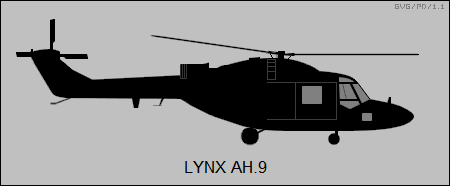
The AH.9 (and older AH.7s) were later refitted with the GEC-Marconi ARI 23491 AWARE-3 RWR, replacing the Sky Guardian RWR. The AH.9s were also refitted with true passenger seats to improve crashworthiness, reducing load to six equipped or nine unequipped troops. Since elimination of the landing skids meant that troops rappelling out of the helicopter didn't have a convenient step outside the doors, provisions were added for a bolt-on step. The new landing gear scheme prevented the AH.9 from using the same TOW carriage arrangement as the AH.7, and so the AH.9s were not used in the tank-killer role. Westland did consider a new TOW carriage arrangement, Hellfire carriage, optional T800 engines, and a wide range of other enhancements for the AH.9 as the "Battlefield Lynx" for the export market, but nobody bought off on the idea.
The Lynx was replaced in the anti-armor role by the Boeing / Westland WAH-64 Apache AH Mark 1 gunship, armed with the more potent Hellfire anti-armor missile. The anti-armor machines were switched to the light utility helicopter role. Interestingly, the British Army used the Lynx Mark 7 during the occupation of Iraq from the spring of 2003, mostly because the Mark 9 had a navigation kit designed for use in Germany and the Mark 7's navigation kit was more appropriate for Iraq. The lighter weight -- about 90 kilograms / 200 pounds less -- was also an asset in the hot climate. British Army and Royal Marine Lynxes saw action in Afghanistan as well.
The Lynx as such has been retired from the British military -- though British Army and Royal Marines are currently flying the improved "Lynx Wildcat", discussed later.
* The army variants of the Lynx had very little success in the export market, with a grand total of three "Lynx Mark 28s" sold to the police force of Qatar, all three being delivered in 1978. These machines were similar to the Lynx AH.1, the major differences being fit of sand filters and some different communications electronics. They were updated with Gem 41-7 engines during their time of service. They were sold back to Britain in 1991. There was an effort to sell army Lynxes to a number of other Arab states that got to an advanced stage, but then fell apart.
The low sales were a bit puzzling. It might be thought that the Army Lynx simply could not meet the competition presented by the US Bell UH-1 Huey and then the US Sikorsky S-70 series, both of which were widely sold all over the planet -- but naval variants of the Lynx proved very successful in the export market against much the same competition. In fact, the Lynx was so identified as a naval helicopter that there was a popular inclination to believe it was originally designed for naval requirements and then adopted by the army, when the truth was exactly the opposite.
BACK_TO_TOP